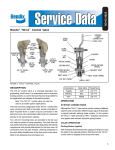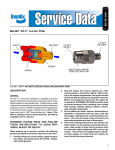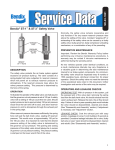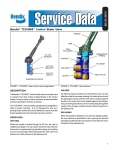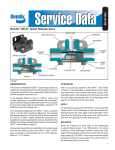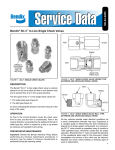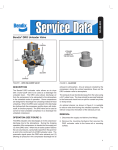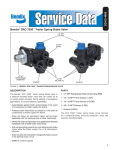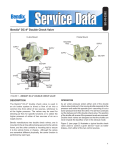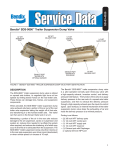Download BENDIX BW1808 User's Manual
Transcript
SD-03-906 ® Bendix® QR-L™ Inline Quick Release Valve WRENCH FLAT SUPPLY PORT (MALE PIPE THREAD) NUT & STAR WASHER EXHAUST WRENCH FLAT SUPPLY PORT (FEMALE PIPE THREAD) EXHAUST DELIVERY PORT DELIVERY PORT Direct Mount QR-L™ Valve Frame or Bracket Mount QR-L™ Valve FIGURE 1 - QR-L™ INLINE QUICK RELEASE VALVE DESCRIPTION The Bendix® QR-L™ quick release valve is similar to standard quick release valves such as the QR-1™, QR-N™, and QRN-2™. Its purpose is to “speed up” the release of air from air lines and devices it is attached to. Although primarily intended to enhance air system performance by rapidly exhausting supply or control air pressure from vehicle air lines, it can be used in a variety of different applications. It is uniquely suitable as an air system performance enhancement due to its 0 psi crack and differential pressure. Supply and delivery pressure is the same throughout the air pressure range. A typical air system application for the QR-L™ valve is illustrated in figure 3. The QR-L™ valve is non-serviceable. It incorporates a single supply and delivery port along with two exhaust ports. Two versions of the QR-L™ valve are available as illustrated in figure 1. Male pipe threads at the supply port, on the direct mount version, allow installation in another air device. A 1-1/8” machine thread on the exterior of the supply port and a 3/8” PT female air connection on the second version permits installation in a bracket or a hole in a frame or cross member on the vehicle. BODY CRIMPED TO CAP O-RING BODY DELIVERY PORT SUPPLY PORT CAP 3 AIR CHANNELS (0 PSI CRACK & DIFFERENTIAL) DIAPHRAGM EXHAUST DIAPHRAGM FIGURE 2 - QR-L™ INLINE QUICK RELEASE VALVE An arrow, embossed in the cast body, indicates the flow of air through the valve, from supply to delivery. Supply port: 1/2"-Male P.T. or 3/8"-Female P.T. Delivery ports: 1/2" Female P.T. Weight: .6 lb. Material: Die cast zinc Operating pressure: 150 psi maximum Operating temperature: -40° to 200° F 1 Exhaust Tractor Protection Valve Service Brake Valve Supply Control Line QR-L™ Valve Trailer Control Valve Delivery Diaphragm Exhaust Trailer Supply Valve Supply Line QR-L™ Valve FIGURE 5 QR-L™ INLINE QUICK RELEASE VALVE BALANCED MODE Exhaust FIGURE 3 TYPICAL QR-L™ INLINE QUICK RELEASE VALVE AIR SYSTEM APPLICATION Supply OPERATION 0 psi Crack & Differential Pressure Unlike standard quick release valves, the QR-L™ valve maintains the same pressure at the supply and delivery ports (0 psi crack and differential) throughout the entire pressure range during both apply and release modes. Three radial channels in the cap, along with a specially shaped diaphragm, provide the QR-L™ valve with this feature. Delivery Diaphragm Exhaust FIGURE 6 QR-L™ INLINE QUICK RELEASE VALVE RELEASE MODE Apply When air pressure enters the supply port, it causes the center portion of the diaphragm to seal the exhaust in the body. Supply air pressure simultaneously forces the edges of the diaphragm away from its seat on the cap, allowing air to flow freely out the delivery port. Delivery pressure is the same as supply pressure. Balance When delivery air pressure (pressure beneath diaphragm) is equal to supply air pressure above the diaphragm, the outer edges of the diaphragm seat against the cap. The exhaust remains sealed because air pressure bears against the center portion of the diaphragm from one side only. Exhaust Release When air pressure is removed or reduced rapidly at the QR-L™ valve supply port, the air pressure on the delivery side of the diaphragm holds the outer edge of the diaphragm against its seat on the cap while simultaneously moving the center portion away from the exhaust port in the body. Air from the delivery port flows out the exhaust ports. If air pressure is reduced slowly at supply port, air may not flow out the exhaust ports. When delivery air pressure is fully exhausted, the diaphragm will return to its natural state, with its outer edges seated on the cap and the center portion seated against the exhaust in the body. WARNING! PLEASE READ AND FOLLOW THESE INSTRUCTIONS TO AVOID PERSONAL INJURY OR DEATH: Supply When working on or around a vehicle, the following general precautions should be observed at all times. Delivery Diaphragm Exhaust ™ FIGURE 4 QR-L INLINE QUICK RELEASE VALVE AIR APPLIED TO SUPPLY PORT 2 1. Park the vehicle on a level surface, apply the parking brakes, and always block the wheels. Always wear safety glasses. 2. Stop the engine and remove ignition key when working under or around the vehicle. When working in the engine compartment, the engine should be shut off and the ignition key should be removed. Where circumstances require that the engine be in operation, EXTREME CAUTION should be used to prevent personal injury resulting from contact with moving, rotating, leaking, heated or electrically charged components. 3. Do not attempt to install, remove, disassemble or assemble a component until you have read and thoroughly understand the recommended procedures. Use only the proper tools and observe all precautions pertaining to use of those tools. 4. If the work is being performed on the vehicle’s air brake system, or any auxiliary pressurized air systems, make certain to drain the air pressure from all reservoirs before beginning ANY work on the vehicle. If the vehicle is equipped with an AD-IS™ air dryer system or a dryer reservoir module, be sure to drain the purge reservoir. 5. Following the vehicle manufacturer’s recommended procedures, deactivate the electrical system in a manner that safely removes all electrical power from the vehicle. 6. Never exceed manufacturer’s recommended pressures. 7. Never connect or disconnect a hose or line containing pressure; it may whip. Never remove a component or plug unless you are certain all system pressure has been depleted. 8. Use only genuine Bendix ® replacement parts, components and kits. Replacement hardware, tubing, hose, fittings, etc. must be of equivalent size, type and strength as original equipment and be designed specifically for such applications and systems. 9. Components with stripped threads or damaged parts should be replaced rather than repaired. Do not attempt repairs requiring machining or welding unless specifically stated and approved by the vehicle and component manufacturer. 10. Prior to returning the vehicle to service, make certain all components and systems are restored to their proper operating condition. SERVICE CHECKS PREVENTIVE MAINTENANCE 3. Test all air fittings for excessive leakage and tighten as needed. Perform OPERATIONAL AND LEAKAGE TESTS before placing the vehicle back into service. Important: Review the Bendix Warranty Policy before performing any intrusive maintenance procedures. A warranty may be voided if intrusive maintenance is performed during the warranty period. No two vehicles operate under identical conditions, as a result, maintenance intervals may vary. Experience is a valuable guide in determining the best maintenance interval for air brake system components. At a minimum, the QR-L™ valve should be inspected every 12 months or 3600 operating hours, whichever comes first, for proper operation. Should the QR-L™ valve not meet the elements of the operational tests noted in this document, further investigation and service of the valve may be required. 1. Remove any accumulated contaminants. Visually inspect the valve’s exterior for physical damage. Replace the valve if excessive physical damage is noted. 2. Inspect all air lines connected to the valve for signs of wear or physical damage. Repair or replace as necessary. OPERATIONAL AND LEAKAGE TESTS 1. Block the vehicle’s wheels and fully charge the air system. 2. Apply and release air pressure rapidly to the QR-L™ valve several times and check for prompt response. 3. With air pressure applied to the supply port, apply a soap solution to the QR-L™ valve exhaust ports. Leakage of a 1” bubble in 5 seconds is permissible. 4. With the brakes still applied to the supply port, apply a soap solution around the valve where the cap and body are joined. No leakage at this point is permitted. If the valve does not function as described, or if leakage is excessive, replace it at any authorized parts outlet. REMOVAL 1. Identify and mark or label all air lines and their connections to the QR-L™ valve. Then disconnect the air lines. Use the QR-L™ valve wrench flat, closest to the air line or fitting being removed. 2. Remove the QR-L™ valve from the vehicle. Retain the mounting hardware, if any. INSTALLATION 1. Install the QR-L™ valve on the vehicle using the mounting hardware, if any, saved during removal. 2. Reconnect all air lines to the valve using the identification made during removal. Note: An arrow embossed in the body of the vale indicates the direction of air flow and points toward the delivery port. Use the QR-L™ valve wrench flat, closest to the air line or fitting being installed. NOTE: The construction of the QR-L™ valve prevents disassembly/assembly. It is a non-serviceable device and cannot be repaired. If the QR-L™ valve does not meet the operational and leakage tests, it must be replaced. Replacements are available at any authorized Bendix parts outlet. 3 4 BW1808 © 2004 Bendix Commercial Vehicle Systems LLC All rights reserved. 3/2004 Printed in U.S.A.





